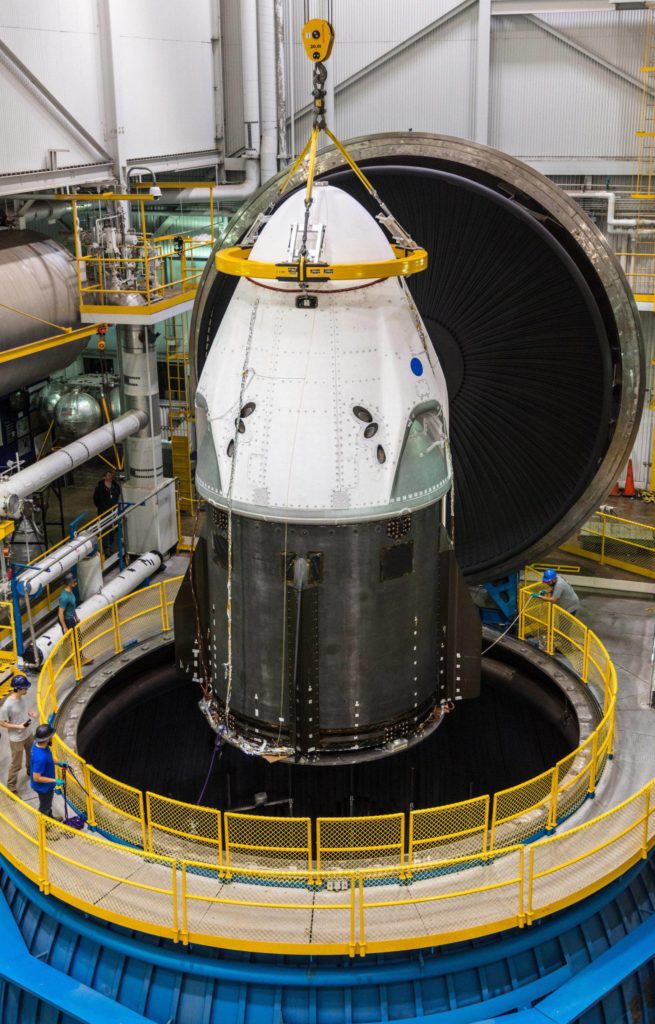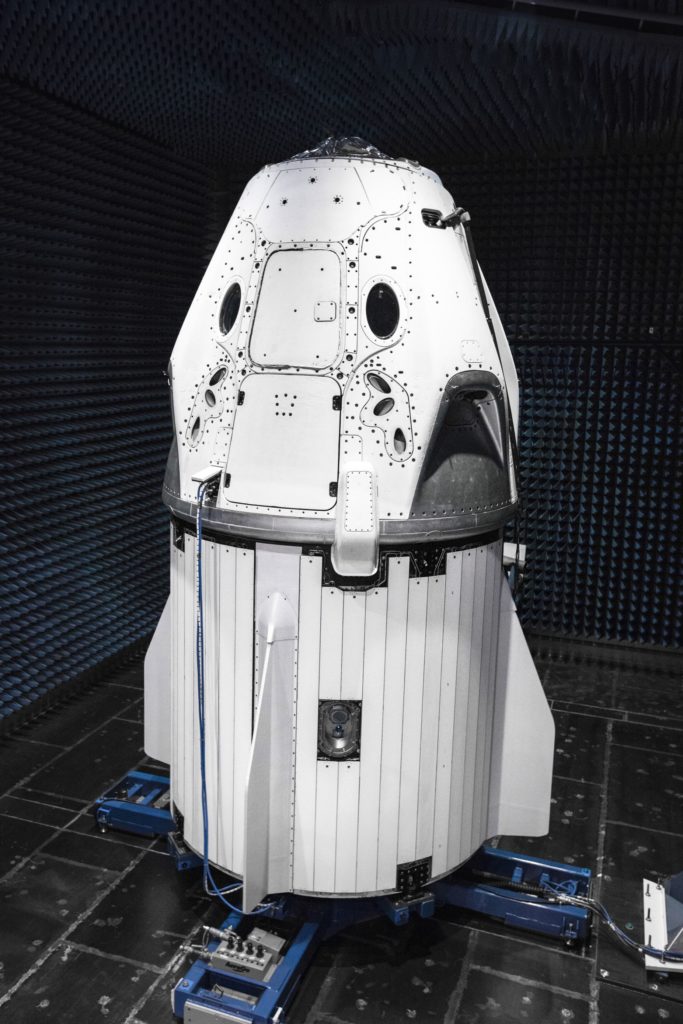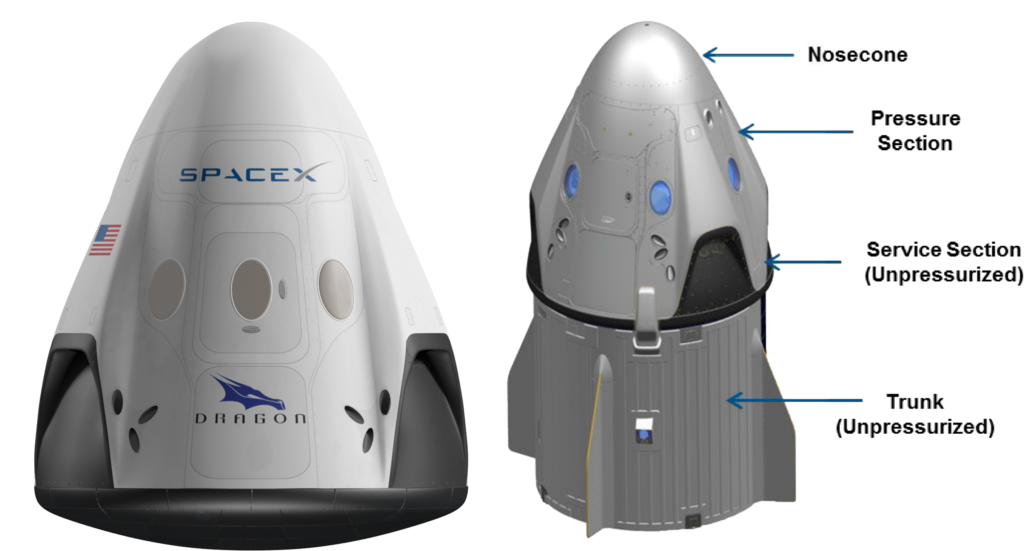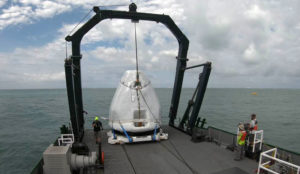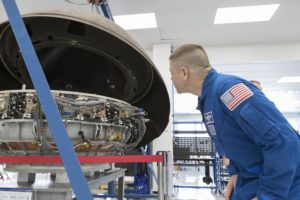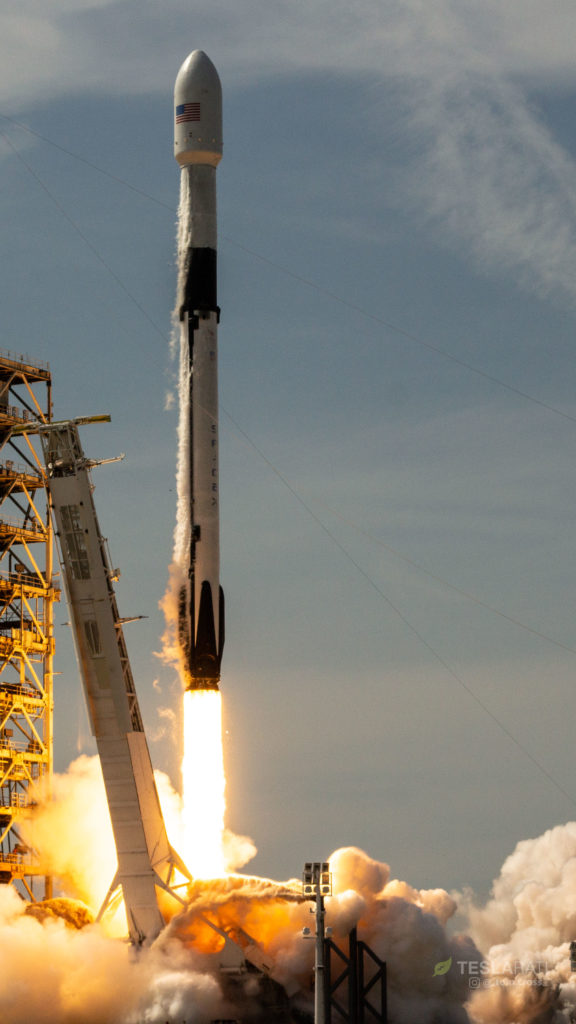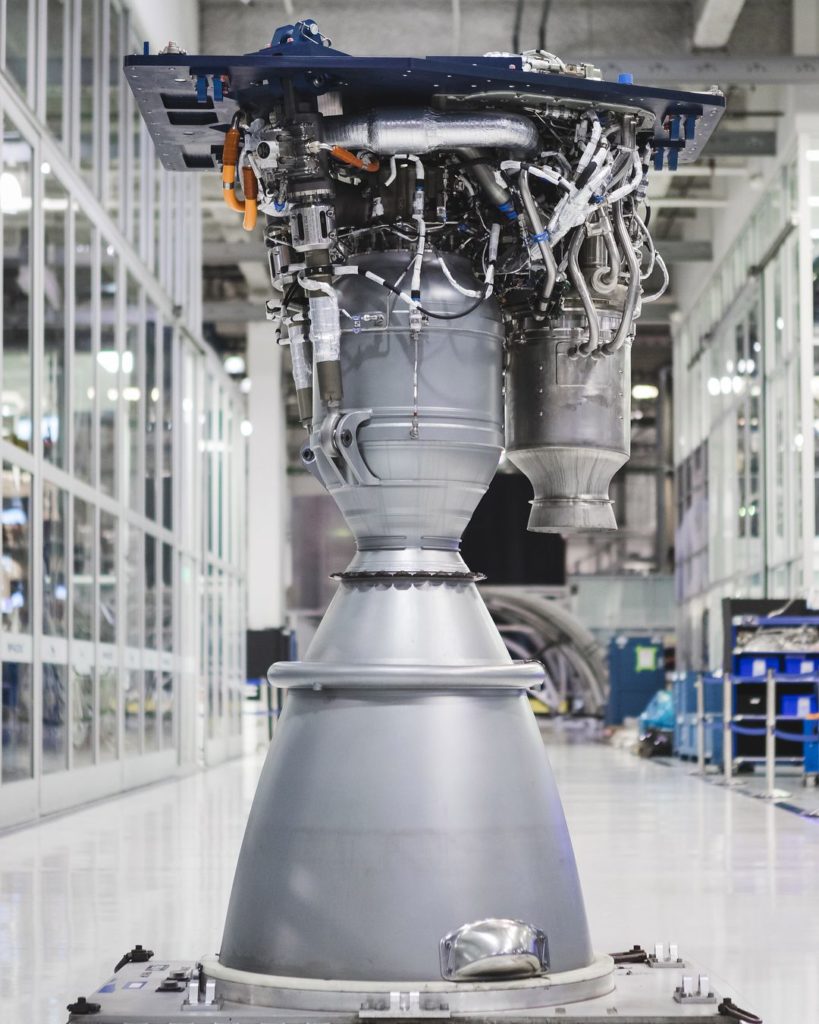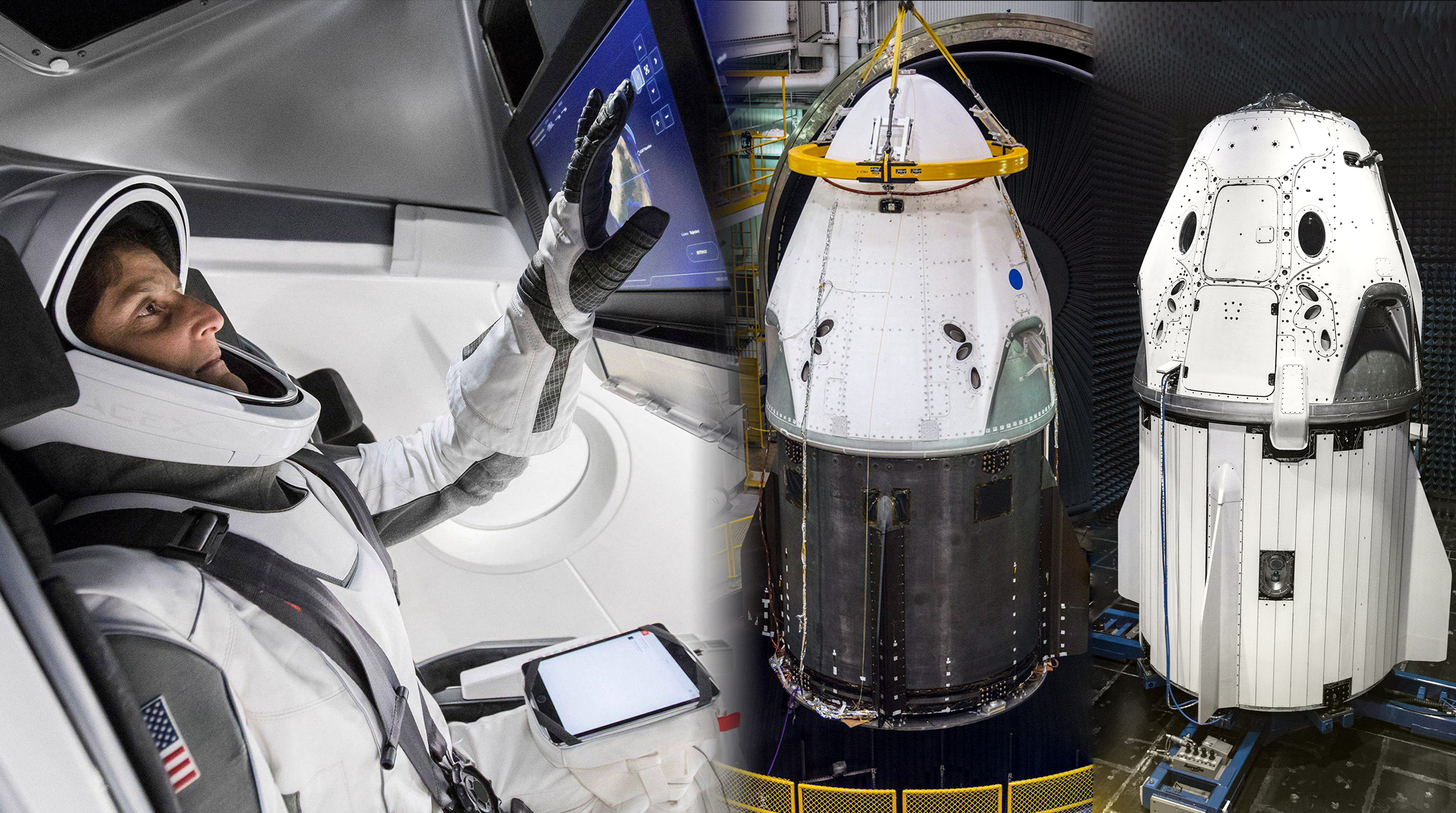

News
SpaceX’s Crew Dragon spaceship marches towards launch with vacuum chamber test
SpaceX has published the latest photo of its next-generation Crew Dragon spacecraft, showing the crewed vehicle preparing to be put through its paces inside a NASA thermal vacuum chamber located in Cleveland, Ohio. If the tests are completed without issue, the Dragon’s next destination will be Cape Canaveral, Florida, where it will prepare for an inaugural launch targeted for the fourth quarter of 2018.
In the photo released on June 20th, SpaceX’s DM-1 Crew Dragon capsule (C202 in shorthand: [C]apsule, Dragon [2], serial number [02]) is seen being craned by SpaceX technicians into the thermal vacuum chamber at NASA’s Plum Brook testing facilities. Located in Ohio, Plum Brook’s vacuum chamber is unique because of both its size and its ability to fairly accurate replicate the actual environment faced by satellites and spacecraft once in space. Most importantly, this includes the extreme thermal conditions those vehicles are subjected to by constant ~90-minute day-night cycles in low Earth orbit (LEO).
Without Earth’s cozy atmosphere to act as both a heat sink and insulating blanket once on orbit, there is simply nothing there to protect spacecraft like Crew Dragon from the absolute extremes of direct solar radiation (sunlight), total darkness, and a complete lack of cooling by conduction and convection. In order to avoid overheating, Crew Dragon thus needs to bring along its own means of cooling in the form of onboard radiators to shed excess heat. The use of white paint on spacecraft further aids this process by selectively preventing the absorption of solar radiation while simultaneously efficiently emitting in infrared wavelengths.
- SpaceX’s Demo Mission-1 Crew Dragon seen preparing for vacuum tests at a NASA-run facility, June 2018. (SpaceX)
- The DM-1 Crew Dragon testing inside SpaceX’s anechoic chamber, May 2018. (SpaceX)
- An overview of Crew Dragon’s main features, all of which can be seen in the real-life photos. The Cargo Dragon version will likely remove seats and windows. (SpaceX)
How to prep your Dragon
Crew Dragon’s primary radiators are elegantly integrated into vertical panels installed on the cylindrical bottom segment, known as the trunk, while the craft’s power source – solar panels in this case – are installed in a curved array on the opposite side of the trunk. Intriguingly, the trunks displayed in the two most recent photos of the DM-1 Crew Dragon appear to be almost completely different, and the trunk at Plum Brook does not appear to have its solar arrays or radiators installed. Nominally, SpaceX would use the thermal vacuum capabilities of the Ohio facility to fully vet Crew Dragon’s ability to maintain optimal temperatures on orbit, but the particularly tests planned for the DM-1 capsule and trunk may be of a slightly different type.
- On February 28, SpaceX completed a demonstration of their ability to recover the crew and capsule after a nominal water splashdown in the Atlantic Ocean, just off the coast of Florida. (SpaceX)
- Astronaut Bob Behnken examines a sample of Crew Dragon docking and crew transfer hardware, the mechanisms that will allow the spacecraft to dock with the International Space Station and allow crew to enter the orbital outpost. Taken March 2017. (SpaceX)
Regardless, after testing at Plum Brook is completed, the DM-1 Crew Dragon capsule will be shipped to a newly-constructed processing facility in Cape Canaveral, Florida, while it’s understood that the trunk installed in SpaceX’s June 20th photo will be returned to the Hawthorne, CA factory to be outfitted with flight hardware (presumably including cameras, radiators, solar arrays, and a healthy amount of insulation). It’s unclear when the two segments of DM-1 will part ways and head on to their next destinations, but it’s likely that testing at Plum Brook will last for at least a handful of weeks.
Birds of a feather
In the meantime, several additional Crew Dragon capsules/trunks and the Falcon 9 Block 5 rockets that will launch them are in a variety of states of fabrication and assembly at SpaceX’s Hawthorne factory. B1051, the Block 5 booster assigned to the first uncrewed Demo-1 launch of Crew Dragon, was reported by NASA to be undergoing propellant tank integration in March 2018, implying that the rocket should be at or near the final stages of integration, and will likely ship to McGregor, Texas for static fire testing late this summer.
As of June 15th, SpaceX’s third Falcon 9 Block 5 booster was vertical on the Texas test stand, likely nearing its own static fire test before being shipped to SpaceX’s Vandenberg Air Force Base launch facilities for the July 20th launch of Iridium-7. While possible that a booster slipped past the watchful eyes and ears of SpaceX enthusiast observers, it’s probable that the rocket currently in McGregor is B1048, implying that a minimum of two additional booster shipments and Texas test programs remain before B1051 can be prepped to launch SpaceX’s first Crew Dragon mission. At the current marginally accelerated booster production and shipment schedule (~ 30-day cadence), B1051 would be expected to leave Hawthorne for Texas no earlier than (NET) late August or early September. This meshes with a recent comment from Commercial Crew astronaut Suni Williams:
“I think we’re going to get the [uncrewed[ demo flights probably by the end of the year, maybe a little after that . . . and then the crew demo missions next year.”
- Falcon 9 Block 5 completed its first launch on May 11, carrying the Bangabandhu-1 communications satellite to geostationary transfer orbit. (Tom Cross)
- SpaceX’s second Block 5 booster was spotted vertical at the company’s McGregor, TX testing facilities. That booster has since been shipped to Florida for a mid-July launch, with B1048 now in its place as of June 15. (Aero Photo)
- A matte-silver Block 5 Merlin 1D rocket engine seen preparing to leave SpaceX’s Hawthorne factory for testing in Texas. (SpaceX)
Anticipating acceptance and prelaunch testing that is far more extensive and time-consuming than typically seen with SpaceX’s commercial missions, it’s safe to bet that the first uncrewed Crew Dragon mission – DM-1 – will launch from Kennedy Space Center in November or December 2018. While those operations proceed over the course of the rest of this year, SpaceX expects roughly 10 additional Falcon 9 and Falcon Heavy launches to occur. It’s gonna be a busy H2.
Follow us for live updates, peeks behind the scenes, and photos from Teslarati’s East and West Coast photographers.
Teslarati – Instagram – Twitter
Tom Cross – Twitter
Pauline Acalin – Twitter
Eric Ralph – Twitter

News
Tesla removes Safety Monitors, begins fully autonomous Robotaxi testing
This development, in terms of the Robotaxi program, is massive. Tesla has been working incredibly hard to expand its fleet of Robotaxi vehicles to accommodate the considerable demand it has experienced for the platform.

Tesla has started Robotaxi testing in Austin, Texas, without any vehicle occupants, the company’s CEO Elon Musk confirmed on Sunday. Two Tesla Model Y Robotaxi units were spotted in Austin traveling on public roads with nobody in the car.
The testing phase begins just a week after Musk confirmed that Tesla would be removing Safety Monitors from its vehicles “within the next three weeks.” Tesla has been working to initiate driverless rides by the end of the year since the Robotaxi fleet was launched back in June.
Two units were spotted, with the first being seen from the side and clearly showing no human beings inside the cabin of the Model Y Robotaxi:
A Tesla without a driver was spotted traveling on public roads! pic.twitter.com/ZLbduf4cKa
— TESLARATI (@Teslarati) December 14, 2025
Another unit, which is the same color but was confirmed as a different vehicle, was spotted just a few moments later:
NEWS: A second Tesla Model Y Robotaxi running FSD Unsupervised has just been spotted driving itself on public roads in Austin, Texas, with no one in the front seats.
This is a different car from the one spotted earlier. They have different license plates.
h/t @Mandablorian https://t.co/5URYsUGyD0 pic.twitter.com/CIUi4mXi33
— Sawyer Merritt (@SawyerMerritt) December 14, 2025
The two units are traveling in the general vicinity of the South Congress and Dawson neighborhoods of downtown Austin. These are located on the southside of the city.
This development, in terms of the Robotaxi program, is massive. Tesla has been working incredibly hard to expand its fleet of Robotaxi vehicles to accommodate the considerable demand it has experienced for the platform.
However, the main focus of the Robotaxi program since its launch in the Summer was to remove Safety Monitors and initiate completely driverless rides. This effort is close to becoming a reality, and the efforts of the company are coming to fruition.
Testing is underway with no occupants in the car
— Elon Musk (@elonmusk) December 14, 2025
It is a drastic step in the company’s trek for self-driving technology, as it plans to expand it to passenger vehicles in the coming years. Tesla owners have plenty of experience with the Full Self-Driving suite, which is not fully autonomous, but is consistently ranked among the best-performing platforms in the world.
News
Tesla refines Full Self-Driving, latest update impresses where it last came up short
We were able to go out and test it pretty extensively on Saturday, and the changes Tesla made from the previous version were incredibly impressive, especially considering it seemed to excel where it last came up short.

Tesla released Full Self-Driving v14.2.1.25 on Friday night to Early Access Program (EAP) members. It came as a surprise, as it was paired with the release of the Holiday Update.
We were able to go out and test it pretty extensively on Saturday, and the changes Tesla made from the previous version were incredibly impressive, especially considering it seemed to excel where it last came up short.
Tesla supplements Holiday Update by sneaking in new Full Self-Driving version
With Tesla Full Self-Driving v14.2.1, there were some serious regressions. Speed Profiles were overtinkered with, causing some modes to behave in a strange manner. Hurry Mode was the most evident, as it refused to go more than 10 MPH over the speed limit on freeways.
It would routinely hold up traffic at this speed, and flipping it into Mad Max mode was sort of over the top. Hurry is what I use most frequently, and it had become somewhat unusable with v14.2.1.
It seemed as if Speed Profiles should be more associated with both passing and lane-changing frequency. Capping speeds does not help as it can impede the flow of traffic. When FSD travels at the speed of other traffic, it is much more effective and less disruptive.
With v14.2.1.25, there were three noticeable changes that improved its performance significantly: Speed Profile refinements, lane change confidence, and Speed Limit recognition.
🚨 Many of you asked us to test highway driving with Tesla Full Self-Driving v14.2.1.25. Here’s what we noticed:
✅ Speed Profiles are significantly improved. Hurry Mode is no longer capped at 10 MPH over the speed limit, and now travels with the flow of traffic. This is much… pic.twitter.com/48ZCGbW0JO
— TESLARATI (@Teslarati) December 13, 2025
Speed Profile Refinement
Speed Profiles have been significantly improved. Hurry Mode is no longer capped at 10 MPH over the speed limit and now travels with the flow of traffic. This is much more comfortable during highway operation, and I was not required to intervene at any point.
With v14.2.1, I was sometimes assisting it with lane changes, and felt it was in the wrong place at the wrong time more frequently than ever before.
However, this was one of the best-performing FSD versions in recent memory, and I really did not have any complaints on the highway. Speed, maneuvering, lane switching, routing, and aggressiveness were all perfect.
Lane Changes
v14.2.1 had a tendency to be a little more timid when changing lanes, which was sort of frustrating at times. When the car decides to change lanes and turn on its signal, it needs to pull the trigger and change lanes.
It also changed lanes at extremely unnecessary times, which was a real frustration.
There were no issues today on v14.2.1.25; lane changes were super confident, executed at the correct time, and in the correct fashion. It made good decisions on when to get into the right lane when proceeding toward its exit.
It was one of the first times in a while that I did not feel as if I needed to nudge it to change lanes. I was very impressed.
Speed Limit Recognition
So, this is a complex issue. With v14.2.1, there were many times when it would see a Speed Limit sign that was not meant for the car (one catered for tractor trailers, for example) or even a route sign, and it would incorrectly adjust the speed. It did this on the highway several times, mistaking a Route 30 sign for a 30 MPH sign, then beginning to decelerate from 55 MPH to 30 MPH on the highway.
This required an intervention. I also had an issue leaving a drive-thru Christmas lights display, where the owners of the private property had a 15 MPH sign posted nearly every 200 yards for about a mile and a half.
The car identified it as a 55 MPH sign and sped up significantly. This caused an intervention, and I had to drive manually.
It seems like FSD v14.2.1.25 is now less reliant on the signage (maybe because it was incorrectly labeling it) and more reliant on map data or the behavior of nearby traffic.
A good example was on the highway today: despite the car reading that Route 30 sign and the Speed Limit sign on the center screen reading 30 MPH, the car did not decelerate. It continued at the same speed, but I’m not sure if that’s because of traffic or map data:
🚨 We listened to and read a lot of you who had a complaint of Tesla Full Self-Driving v14.2.1 incorrectly reading Speed Limit signs
This appears to be resolved in v14.2.1.25.
Here’s a breakdown: pic.twitter.com/TEP03xrMbt
— TESLARATI (@Teslarati) December 13, 2025
A Lone Complaint
Tesla has said future updates will include parking improvements, and I’m really anxious for them, because parking is not great. I’ve had some real issues with it over the past couple of months.
Today was no different:
🚨 My lone complaint with my drive on Tesla FSD v14.2.1.25 was this strange parking instance.
FSD swung out wide to the left to pull into this spot and this is where it seemed to be stumped. I gave it about 10 seconds after the car just stopped moving for it to make some… https://t.co/ZEkhTHOihG pic.twitter.com/TRemXu5DLf
— TESLARATI (@Teslarati) December 13, 2025
Full Self-Driving v14.2.1.25 is really a massive improvement over past versions, and it seems apparent that Tesla took its time with fixing the bugs, especially with highway operation on v14.2.1.
News
Tesla hints at Starlink integration with recent patent
“By employing polymer blends, some examples enable RF transmission from all the modules to satellites and other communication devices both inside and outside the vehicle.”

Tesla hinted at a potential Starlink internet terminal integration within its vehicles in a recent patent, which describes a vehicle roof assembly with integrated radio frequency (RF) transparency.
The patent, which is Pub. No U.S. 2025/0368267 describes a new vehicle roof that is made of RF-transparent polymer materials, allowing and “facilitating clear communication with external devices and satellites.”
Tesla believes that a new vehicle roof design, comprised of different materials than the standard metallic or glass elements used in cars today, would allow the company to integrate modern vehicular technologies, “particularly those requiring radio frequency transmission and reception.
Tesla has recently filed a US patent application on integrating RF transparent materials into the roof structure.
“facilitating clear communication with external devices and satellites”
Tesla fleet is getting @Starlink connectivity integration soon. LFG @Tesla @elonmusk… pic.twitter.com/bLa8YtPLd1
— Chansoo Byeon (@Chansoo) December 9, 2025
Instead of glass or metallic materials, Tesla says vehicles may benefit from high-strength polymer blends, such as Polycarbonate, Acrylonitrile Butadiene Styrene, or Acrylonitrile Styrene Acrylate.
These materials still provide ideal strength metrics for crashworthiness, stiffness for noise, vibration, and harshness control, and are compliant with head impact regulations.
They would also enable better performance with modern technologies, like internet terminals, which need an uninterrupted signal to satellites for maximum reception. Tesla writes in the patent:
“By employing polymer blends, some examples enable RF transmission from all the modules to satellites and other communication devices both inside and outside the vehicle.”

One of the challenges Tesla seems to be aware of with this type of roof design is the fact that it will still have to enable safety and keep that at the forefront of the design. As you can see in the illustration above, Tesla plans to use four layers to increase safety and rigidity, while also combating noise and vibration.
It notes in the patent that disclosed examples still meet the safety requirements outlined in the Federal Motor Vehicle Safety Standards (FMVSS).
Starlink integrated directly into Tesla vehicles would be a considerable advantage for owners. It would come with a handful of distinct advantages.
Initially, the inclusion of Starlink would completely eliminate cellular dead zones, something that is an issue, especially in rural areas. Starlink would provide connectivity in these remote regions and would ensure uninterrupted service during road trips and off-grid adventures.
It could also be a critical addition for Robotaxi, as it is crucial to have solid and reliable connectivity for remote monitoring and fleet management.
Starlink’s growing constellation, thanks to SpaceX’s routine and frequent launch schedule, will provide secure, stable, and reliable internet connectivity for Tesla vehicles.
Although many owners have already mounted Starlink Mini dishes under their glass roofs for a similar experience, it may be integrated directly into Teslas in the coming years, either as an upgrade or a standard feature.
